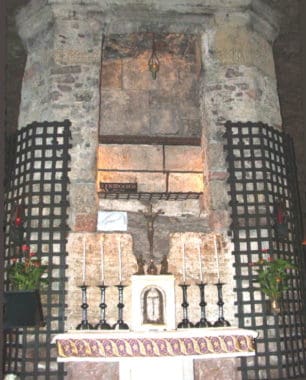RELICS (Part I of III)
Dear Father John, The discussion about cremation and preserving the head of St. Catherine had me thinking. Why stop at the head? What about all the incorruptible bodies in the Church – St. Pio and St. Bernadette of Lourdes to name two – should they be on public display?? Is that a reverent ‘disposal’ of the body? Kindly clarify. With thanks.
It’s possible to get too complicated with issues like these. Sensibilities can vary considerably among individuals who each have strong faith and healthy devotion. Sensibilities are influenced strongly by cultural and historical factors, and although we would often like to achieve a high level of clarity on devotional practices, the bottom line is that popular piety and devotional traditions simply don’t lend themselves to the kind of precision that dogma does. That said, perhaps it will be useful to review some of the spiritual values associated with relics in general, even though it may take us some time to do so. The spirituality of relics makes it clear why a Catholic relic is entirely different from any type of pagan offering, including a shrunken head. After this brief foray into unfamiliar (for many) spiritual territory, our readers can apply these principles to different scenarios that interest them. Let’s start with a famous example.
The Awe-Inspiring Tomb of St. Francis
Some say that St. Francis of Assisi, the Founder of the Franciscan Order who died in 1226, has been the most Christ-like person to walk the earth since Christ left. Even non-believers who visit his tomb go away deeply moved.
 The tomb is embedded in a pillar of rock hewn from the ground deep underneath the basilica erected in his honor in his home town of Assisi. After visiting the basilica, tourists and pilgrims descend a long flight of stairs to admire the altars and artwork in the beautiful crypt on the lower level. A small sign directs visitors who want to pay their respects to the saint himself even farther down. As they go down the narrow staircase they enter a crowded, unadorned chapel carved from the living rock of the mountain where the ancient town of Assisi was built. Pilgrims from all over the world kneel there, quietly contemplating the final resting place of the great Saint and Founder. As you approach the tomb, the reverent silence enfolds you, broken only by the muffled taps of pilgrim shoes on the cold stone floor, the hushed rustle of whispered prayers, and the comforting click of rosary beads.
The tomb is embedded in a pillar of rock hewn from the ground deep underneath the basilica erected in his honor in his home town of Assisi. After visiting the basilica, tourists and pilgrims descend a long flight of stairs to admire the altars and artwork in the beautiful crypt on the lower level. A small sign directs visitors who want to pay their respects to the saint himself even farther down. As they go down the narrow staircase they enter a crowded, unadorned chapel carved from the living rock of the mountain where the ancient town of Assisi was built. Pilgrims from all over the world kneel there, quietly contemplating the final resting place of the great Saint and Founder. As you approach the tomb, the reverent silence enfolds you, broken only by the muffled taps of pilgrim shoes on the cold stone floor, the hushed rustle of whispered prayers, and the comforting click of rosary beads.
Pilgrims can come close to the tomb and walk in a circle around it. In fact, you can only see parts of the heavy stone coffin, which seems to have been lowered into the hollowed-out stone pillar from above. Before the basilica was built, you may have been able to see the top of the pillar, where the opening was, but it has since been capped by the basilica, and now you can only glimpse the coffin through rough windows cut in the pillar expressly for that purpose. As you circle the sepulcher, you can’t help asking yourself, why did they put the coffin there, where no one can get to it, as if it were imprisoned in the rock? If you ask one of the many caretakers of the basilica, they will tell you, very matter-of-factly, that it was in order to make sure the saint’s devotees didn’t break into the tomb and personally appropriate (i.e. steal) pieces of his corpse as relics.
It sounds odd to modern ears – few first-world sophisticates would be tempted to bring home such grisly souvenirs. But it was a real concern in the high Middle Ages, as it was for centuries before and after. When St. Teresa of Avila died in the sixteenth-century, for example, her corpse was dismembered soon after, with representatives from all the major cities of Spain vying with one another to go home with a finger, or an ear, or even an entire arm. The same expression of popular piety explains why St. Catherine of Siena’s body is currently entombed in Rome, where she died, whereas her head is venerated back in her native city of Siena. St. Francis was entombed securely for a reason: to keep his relics together.
What Are Relics?
Relics are of three classes:
- first-class relics are parts of the saint’s body (these are often placed in altars at their consecration);
- second-class relics are part of the clothing or anything used during the saint’s life; and
- third-class relics are any other object, such as a piece of cloth, that has been touched to a first-class relic. Canon law strictly forbids the buying and selling of relics, a practice which bred abuses in past centuries.
Even the Bible condones the veneration of relics. In the Old Testament, the Second Book of Kings records that a dead man was brought back to life when his corpse came into contact with the bones of the great prophet Elisha (cf. II Kings 13:20-21). The Acts of the Apostles describe how pieces of cloth that had touched St. Paul’s skin were used to heal the sick and cast out evil spirits (cf. Acts 19:11-12). By the second century, the veneration of relics was already a widespread Christian practice. After St. Polycarp of Smyrna had been burnt at the stake, for example, his faithful disciples carried off his remains. “We took up his bones,” they later recorded, “which are more valuable than precious stones and finer than refined gold, and laid them in a suitable place, where the Lord will permit us to gather ourselves together, as we are able, in gladness and joy, and to celebrate the birthday of his martyrdom.”
When non-Catholics visit the holy sites of Christian Europe and find relics like these venerated and preserved, they tend to turn up their noses, as if to dismiss the barbaric practices of a primitive, ignorant, morbid civilization. But even if modern secularism considers relics as leftovers from an uncivilized past, the Catholic Church doesn’t, for two very important reasons: the Incarnation and the Resurrection.
Editor’s Note: In Part II, we will discuss how relics are a reiteration of the Incarnation.


